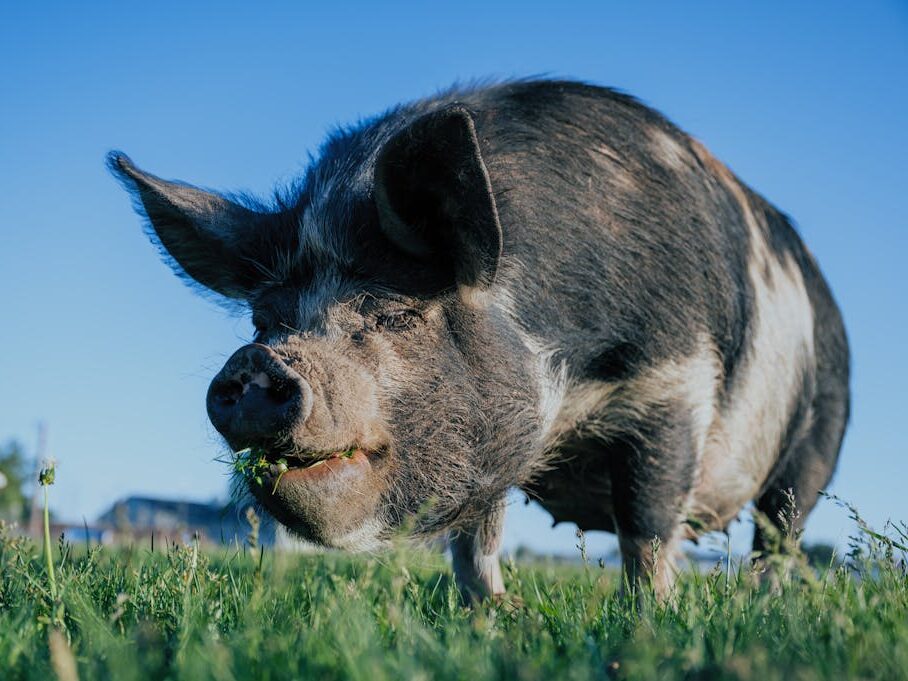
Pigs
From initial registering your pigs through to the final product packaging and labelling.
Updated 7 June 2024
Managing pigs
You must manage your herd actively to ensure their welfare and check on your pigs at least once a day. If you go on holiday, you must therefore get someone qualified to care for pigs to check, feed and water them for you each day.
Marking pigs
Before moving a pig off your farm, you must ensure it has an identifier. There are two types of identifiers: tags and tattoos.
Information recorded in the tag or tattoo depends on where the pig will be moved to:
- Slaughter or a market — identifier must have your herdmark and tags also the prefix ’UK’
- Shows, breeding, semen collection centre — identifier must have a unique individual identification number.
Pigs under 12 months old can be marked with a temporary mark made with paint when moved from farm to farm.
You must replace any lost or illegible identifiers when you notice they are missing.
The Scottish Government has detailed guides on marking pigs:
- Pig identification and registration, Scottish Government
- Livestock identification and traceability: pigs, Scottish Government
Feeding & watering pigs
You are legally responsible for providing your pigs a nutritious diet that supports their wellbeing. Pigs are omnivores, and typically fed with animal feed after being weaned at 8 weeks old.
You must feed pigs at least once a day but feeding your herd twice every day is recommended. Pigs are given more food as they grow, based on their weight. Use body condition scoring (see ’Pig health checks’) to assess whether your pigs may be overweight or undernourished.
If you feed pigs from a trough, you must ensure that there is enough space for all of the pigs to feed at the same time — this will increase as the pigs grow.
Fresh water should be available to pigs at all times, and pigs are very sensitive to dehydration. Outdoors, pigs may push over waterers to create wallows, and they should be checked frequently.
To be certified organic, you need to feed your pigs only organically produced feed and manage their pasture through organically approved methods. Check with your organic certifying body for specific requirements.
Read more:
- ’Feeding pigs’, Accidental Smallholder
- ’4.1. Feed and water’ in Guide to Small-scale Pig Keeping, Soil Association
- ’Feeding your pigs’, Small-scale pig farming
- Webinar: Pig keeping – feeding, Farm Advisory Service
Pasture
You can supplement feed by letting pigs forage outdoors, but most pastures do not provide enough nutrition on their own. When foraging, pigs will turn over and dig up ground to find food. You should rotate their pasture to give areas time to rest and prevent accumulation of manure, which is a health risk.
If you spread animal manure on land, you should wait 2 months before letting pigs graze there.
Feed restrictions
- You must not feed kitchen or catering waste to your pigs.
- Check foods that are poisonous to pigs.
- If you give them animal feed and are selling meat, you must register as a feed business (see ’Feed business registration’).
Breeding pigs
Breeding pigs can be done through letting sows mate with a boar (also called ‘natural service’) or by using artificial insemination (AI). You can either add a boar to the herd or bring it in from another pig farm/croft but you should take care as mixing pigs between herds is a biosecurity risk.
Before choosing sows/gilts for breeding, you should check that they are in a good condition (see ’Pig health checks’). The gestation period for pigs takes 113 days/a bit under four months.
AHDB has useful resources around breeding pigs, including a set of webinars covering breeding, farrowing, and weaning.
You must not wean piglets before they are at least 28 days old, except for health reasons.
Additional resources:
- ’Breeding performance in pigs’, AHDB
- ’Artificial insemination (AI) of pigs’, AHDB
- ’Outdoor Pig Husbandry: A stockperson’s guide to farrowing’, SRUC
Farrowing
Ahead of farrowing (giving birth), pregnant sows should be moved to a specific farrowing area 5 days before, or at the very latest 48 hours before. Pigs like to nest during this time, and you should provide enough bedding material for them to do so.
In organic systems, farrowing crates – where the sow is fully contained – are not permitted
When pigs are farrowing, you should monitor them closely — if the sow is having difficulty giving birth, you may need to intervene or call a vet. Record the number of born and dead piglets.
Any dead piglets and afterbirth are considered animal-by products, and you must dispose of them according to regulations (see ’Pig carcasses & waste’).
Read more:
- ’Farrowing’, Small-scale pig farmer
- ’Farrowing sows and piglets’, Guidance for the Welfare of Pigs, Scottish Government
Cleaning
Maintaining good hygiene in your pig housing and any pasture areas is important for preventing and controlling disease and parasites, and should be part of your biosecurity plan (see ’Biosecurity plan’).
Make sure to wear protective clothing when doing a clean of the house/arc. For disinfecting, you must use a DEFRA approved disinfectant.
AHDB has a useful overview of what you need to do when cleaning and disinfecting spaces used for pig production.